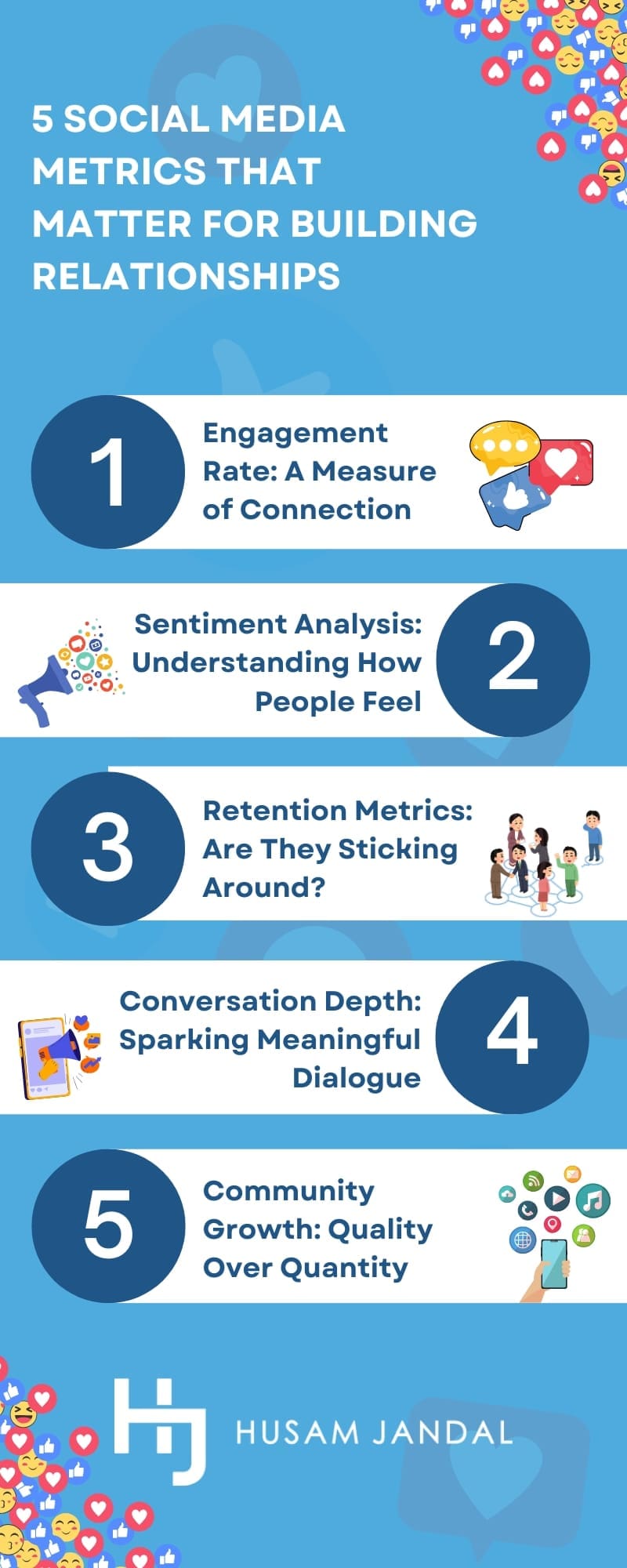 You’ve just finished your latest social media campaign, and the results are in. You should be ecstatic. There are thousands of likes, hundreds of shares, and a ton of views. Yet, something still seems off. Then, it hits you. Despite having all these great numbers, the campaign doesn’t seem to have produced meaningful results. There are no new leads. Sales didn’t increase. There wasn’t even an uptick in conversations with your audience.
You’ve just finished your latest social media campaign, and the results are in. You should be ecstatic. There are thousands of likes, hundreds of shares, and a ton of views. Yet, something still seems off. Then, it hits you. Despite having all these great numbers, the campaign doesn’t seem to have produced meaningful results. There are no new leads. Sales didn’t increase. There wasn’t even an uptick in conversations with your audience.
After pouring time and resources into a social media campaign, this can seem like a nightmare, but it’s an unfortunate reality many businesses face. When it happens to you, it’s easy to think that social media just doesn’t work for your business or that you simply didn’t put in enough effort. Realistically, it’s probably neither of these things. The problem lies in the way you’re measuring success. You’re using vanity metrics.
What Are Vanity Metrics?
Vanity metrics are the shiny numbers on your social media dashboard, such as likes, shares, impressions, and follower counts, that are easy to measure and look great in reports. They’re the kind of stats that catch your eye because they grow fast and feel tangible. But while these numbers can indicate visibility, they don’t always reflect the deeper, more meaningful engagement your business needs to thrive.
The Appeal of Vanity Metrics
Vanity metrics are tempting because they’re simple and immediate. It’s gratifying to see a post rack up thousands of likes or your follower count tick upward. These numbers give a sense of momentum, but the question is: Are they leading to anything actionable?
Consider this: A post with 1,000 likes may look like a success, but if none of those likes come from your target audience or lead to conversations, the impact is limited.
Examples of Vanity Metrics
Some of the most common vanity metrics include:
- Likes and Follower Counts: They indicate visibility but don’t tell you if your audience is engaged or interested in your offerings.
- Impressions: While they show how many people saw your content, they don’t indicate whether those people cared enough to take action.
- Shares without Context: A widely shared post might seem successful, but without understanding why or who is sharing it, you miss the bigger picture.
Vanity Metrics Aren’t Useless, But They’re Incomplete
It’s important to note that vanity metrics aren’t inherently bad. They’re a starting point, offering insight into how far your content is reaching. The key is to avoid treating them as your ultimate measure of success. Instead, think of them as tools to help you ask better questions, such as:
- What type of content generates the most likes or shares?
- Are these metrics driving deeper engagement, such as comments or conversations?
- Do they align with the goals of my campaign?
The Hidden Costs of Overvaluing Vanity Metrics
Focusing too much on vanity metrics can feel like progress, but it often comes at the expense of meaningful growth. When businesses prioritize surface-level stats, they risk overlooking the deeper connections that social media can foster. Let’s break down some of the costs associated with overvaluing these metrics.
Missed Opportunities for Real Engagement
When you measure success by likes and impressions alone, you may ignore the conversations and interactions that matter most. True engagement happens in the comments section, through shared stories, and in private messages—places where trust and loyalty are built.
For example, a brand might celebrate a post with 10,000 likes but miss the chance to respond to 200 meaningful comments, losing out on opportunities to connect directly with customers.
Campaigns That Don’t Drive Business Goals
Vanity metrics don’t always align with your broader business objectives. You might run a campaign that looks great in terms of reach but falls flat when it comes to generating leads or sales. This is because people 70 percent of people who engage with a brand on social media expect a personalized response in return, per Sprout Social. A campaign designed purely for visibility will likely fail to meet these expectations, leaving potential customers disengaged.
Wasted Resources on the Wrong Strategies
Chasing vanity metrics can lead to misallocated budgets and wasted effort. You might invest in flashy content or promotions to boost visibility, but if that content isn’t driving meaningful actions, the ROI will be disappointing. This is what many brands do when boosting posts. Those posts may generate likes, yet fail to create awareness among the target audience.
An Inaccurate Picture of Social Media Success
Vanity metrics can create a false sense of achievement. You may think your campaign is performing well based on likes and shares, but without metrics like conversion rates or retention, the real impact remains unclear. It’s like judging a book by its cover. The surface may look appealing, but you don’t know if it’s delivering value until you dive deeper.
Eroded Trust with Your Audience
Audiences are savvy and can sense when a brand is more focused on numbers than relationships. Overuse of tactics like clickbait headlines or overly promotional posts can turn followers away, damaging your brand’s reputation.
Social Media Metrics That Matter for Building Relationships
If vanity metrics show you how many people are seeing your content, relationship-driven metrics reveal how deeply your audience is connecting with your brand. These are the indicators that reflect trust, loyalty, and genuine engagement—the foundation for long-term success.
Engagement Rate: A Measure of Connection
Engagement rate goes beyond likes and focuses on meaningful interactions like comments, shares, and post clicks. It tells you how your audience is actively participating in the conversation. High engagement rates signal that your content resonates with your audience and encourages two-way communication. For example, a small business might see fewer likes but a steady stream of thoughtful comments and shares, demonstrating real connection over fleeting attention.
Sentiment Analysis: Understanding How People Feel
Sentiment analysis evaluates the tone of conversations about your brand, be it positive, neutral, or negative. It’s not just about what’s being said but how people feel when they engage with your content. Positive sentiment fosters trust and loyalty, while negative feedback can offer opportunities for improvement.
Retention Metrics: Are They Sticking Around?
Retention metrics track whether your audience keeps returning to your page, posts, or community. They’re a strong indicator of loyalty and the strength of your relationship with followers. A loyal audience is more likely to engage, advocate for your brand, and eventually convert into customers.
Conversation Depth: Sparking Meaningful Dialogue

This measures the extent of back-and-forth interaction in your comments or messages. It’s not just about one comment; it’s about creating a dialogue that feels authentic. Deeper conversations build trust and make your audience feel heard.
Community Growth: Quality Over Quantity
While follower growth might seem like a vanity metric, focusing on the quality of your followers, those who engage with your content and align with your target audience, is key. A smaller, engaged community will drive more value than a large but passive following.
How to Transition from Vanity to Value
Shifting your focus from vanity metrics to metrics that truly measure success requires a mindset change. You’ll need to look beyond the surface and commit to building genuine connections with your audience. Here’s how to transition your social media strategy effectively.
Define Clear Goals Aligned with Relationships
Before diving into metrics, ask yourself: What do you want to achieve with your social media campaigns? Instead of chasing likes, focus on objectives like:
- Sparking meaningful conversations.
- Building community trust and loyalty.
- Driving actions like website visits or sign-ups.
For instance, a travel company might shift its goal from increasing follower count to encouraging more comments by asking engaging questions like, “What’s your favorite destination type?”
Use Vanity Metrics as Indicators, Not Outcomes
Remember, vanity metrics aren’t useless. They’re just incomplete. Use them as starting points to understand the reach and visibility of your content, but don’t stop there. Look at what posts generate high likes and explore why they resonated. Combine vanity metrics with engagement-focused data, like comment rates or post clicks. For instance, if a post with high impressions also drives meaningful comments, it’s a sign you’re striking a chord with your audience.
Focus on Creating Value-Driven Content
Instead of chasing trends or posting for visibility alone, create content that provides value to your audience. Value can take many forms:
- Educational: Tips, how-tos, or industry insights.
- Entertaining: Relatable humor, memes, or storytelling.
- Inspiring: Sharing customer success stories or showcasing your brand values.
Prioritize Authentic Engagement
Social media is a two-way street. Instead of just broadcasting, focus on interacting authentically:
- Respond: Reply to comments with thoughtful replies.
- Acknowledge: Engage with and share user-generated content.
- Invite: Use polls or questions to encourage participation.
For example, a retail brand asking followers to vote on their next seasonal color palette encourages engagement and makes followers feel involved in the process.
Leverage Tools for Deeper Social Media Insights
Use social media analytics tools to dig beyond surface-level stats and measure deeper engagement metrics like sentiment, conversion rates, and retention. Platforms like Sprout Social or Hootsuite can help track relationship-focused metrics, and social listening tools can uncover how your audience feels about your brand. For industries like finance, where trust and credibility are paramount, implementing digital marketing strategies tailored for financial services can enhance audience engagement while ensuring compliance with industry regulations.
Test, Learn, and Adapt

Not every campaign will succeed immediately. Test different types of content, track their performance, and adjust based on what works best for building relationships. You can also experiment with formats, including videos, stories, or live sessions, and track how deeper engagement impacts your long-term goals.
Keep Social Media Marketing In-House
It’s very difficult to do all this effectively if you outsource social media marketing. While you can outsource graphic design, writing, and digital marketing strategy, the person behind your social profiles must have internal knowledge of your company and its values, plus be able to respond and engage with your audience quickly and authentically.
Turning Metrics into Meaning
Vanity metrics often grab our attention because they’re easy to measure and visually impressive. But as you’ve seen, they’re only one piece of the puzzle. True success on social media comes from looking deeper and focusing on metrics that reflect meaningful social media engagement, trust, and lasting relationships with your audience.
Reframe Your Approach
Social media isn’t just about visibility. It’s about connection. By shifting your focus from surface-level numbers to relationship-driven metrics, you can create campaigns that resonate on a human level, foster loyalty, and align with your broader business goals.
- Engagement Matters: Likes and shares are nice, but meaningful conversations and comments are where real value lies.
- Relationships Drive Results: Trust and loyalty built through authentic interactions often lead to sales and advocacy without needing a hard sell.
Improve Your Social Media Campaigns and Start Building Relationships
Shifting your approach requires intention, but the rewards are worth it. By aligning your metrics with meaningful outcomes, you’ll improve your campaigns and strengthen the connections that keep your audience coming back. This is why building relationships is central to everything I do as a digital marketing consultant, whether I’m growing a social media following, strengthening a website, or developing email campaigns. If you’d like help building better relationships with your audience, contact me for a free consultation.
FAQs on Social Media Campaigns
What factors determine social media success?
Social media success is determined by how well your campaigns meet your goals and engage your audience. Key factors include creating value-driven content, fostering authentic interactions, and tracking meaningful metrics like engagement rates, sentiment analysis, and audience retention. These indicators provide insights into your social media performance and effectiveness, helping you refine your strategy and align it with your broader business objectives.
How can you improve social media performance and effectiveness?
To improve social media performance and effectiveness, focus on understanding your audience’s needs and preferences. Create content that resonates, encourages interaction, and builds trust. Use analytics to measure metrics that matter, such as meaningful engagement and conversion rates, rather than relying on vanity metrics alone. Consistently test and optimize your campaigns to align with your audience’s evolving expectations.
Why are vanity metrics not enough to measure social media success?
Vanity metrics, like likes and impressions, show visibility but don’t measure deeper engagement or business impact. While they can indicate initial reach, they fail to capture whether your content resonates or leads to meaningful actions like conversions or customer retention. To measure true success, focus on metrics that reveal how your audience interacts with and trusts your brand.
What are the best metrics to track for meaningful social media results?
The best metrics to track include engagement rates, sentiment analysis, and retention metrics. These measure audience connection and loyalty, unlike vanity metrics that only show surface-level reach. Conversion rates and community growth also provide valuable insights into how your social media efforts impact your broader business goals.
How can social media campaigns build better customer relationships?
Social media campaigns build relationships by creating content that adds value, engaging authentically with your audience, and listening to their feedback. Encourage conversations through questions, polls, and responses to comments. Tracking metrics like engagement rates and conversation depth helps refine your strategy for stronger connections.
How do I align social media metrics with my business goals?
Start by defining your goals, such as increasing customer engagement, improving loyalty, or driving conversions. Choose metrics like engagement rates, conversion rates, or audience retention to measure progress. Use analytics tools to track performance and refine your strategy based on insights that align with these objectives.






































































